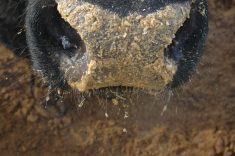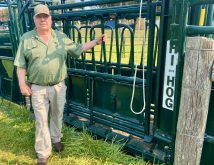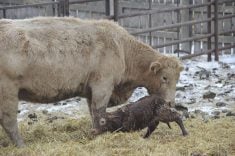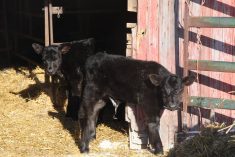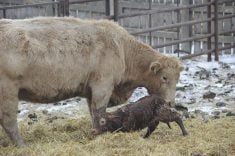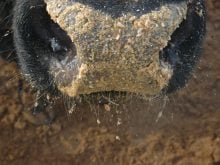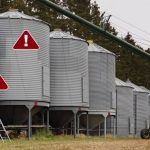Beef producers should consider the five Cs for successful calf management to maximize growth, health and profitability.
Colostrum, calories, consistency, cleanliness and comfort are key elements of successful calf management, says a ruminant nutritionist and production management consultant.
Of those five, colostrum is the most important, says Barry Yaremcio of Yaremcio Ag Consulting Ltd. in Stettler, Alta.
Related story: Preventing weak calf syndrome
Colostrum
Read Also

First-time pig mothers may need more lysine
Lysine feed recommendations may fall short for gilt pregnancies when it comes to making sure the mother pig can produce as much milk for her piglets as possible
“Colostrum is responsible to provide the immunoglobulins needed for short term and long-term immunity.”
Two litres, or five percent of calf weight, should be provided to calves within four hours of birth and an additional two litres should be given within 12 hours of birth. If necessary, bottle feeding is preferable to stomach tubing because it encourages esophageal groove closure and ruminal bypass of colostrum, says Yaremcio.
Colostrum is formed in the last trimester of pregnancy, so it is vital that the cow gets adequate amounts of trace minerals and vitamins.
“The better job you do feeding the cows throughout the entire winter, making sure that she’s in good condition where she’s getting the vitamins and minerals and trace minerals that she needs, the calf will have a better chance to get a healthy start compared to a cow that’s not being supplemented properly,” he says.
“The nutrition program has a huge impact on the quality of the colostrum, so if you’re not feeding proper amounts of trace minerals, vitamins, energy and protein to the cow to keep her in good shape, she won’t produce the colostrum.”
If the colostrum is not available or insufficient, he recommends the use of supplemental colostrum from beef animals rather than dairy.
“The volume of milk that a dairy cow produces dilutes down the colostrum quite a bit, so that’s why you want to have a beef colostrum, if at all possible,” he said.
“There are companies that refine or change the density of the product so they can concentrate the dairy colostrum into something that is suitable for beef. But just going across to the neighbour’s dairy herd and picking up colostrum from them is not the best thing to do.”
Calories
Colostrum initially, and milk later, is the only source of nutrition for a newborn calf so it must have enough to provide the energy, protein, fats, minerals and vitamins required for maintenance, gain and response to cold.
Ensuring good cow condition in advance of calving will also ensure that milk production is adequate to support calf requirements.
Calves that spend energy to stay warm or to mount an immune response will have less energy available for growth, says Yaremcio. They are born with relatively low fat reserves and without colostrum, tissue reserves can be depleted in less than 24 hours.
Early nutrition for the calf is solely dependent upon milk provided by the cow. It takes 45 to 50 days for the rumen to develop enough so the calf can digest other foods.
“Up to that point in time, it all depends on the cow’s condition. If she’s thin, she will not produce as much milk and therefore the calf will not grow up to its genetic potential. … I guess you do the best you can with the cows that you’ve got,” he said.
The colder the calf’s environment, the more milk it will need.
“As the calf grows, it will have the capacity to drink more milk, or milk replacer,” says Yaremcio.
“The other thing is, for a small calf, 5 C might be the lower critical temperature where the animal requires more calories to stay warm compared to temperatures above that point. That’s the heat incremental fermentation or the amount of heat produced by that calf while it’s digesting the feed.
“The smaller the animal, the larger the surface area is compared to body weight and feed consumption. So, the heat loss on a percentage basis from that calf being in the environment goes up.”
Consistency
Calves are creatures of habit and tend to prefer a consistent routine, says Yaremcio.
“There’s really not much to consistency in a beef calf, other than making sure the cow was fed and she’s got milk for the calf,” he says.
“The only thing that applies to the beef calves is they’re provided with dry straw or bedding material to keep them clean on a regular basis.”
Cleanliness
A clean calving environment reduces exposure to potential pathogens, lowers risk of subsequent disease and improves calf health and growth. Clean and dry environments also contribute to greater resistance to cold stress and hypothermia.
Fresh, clean bedding and windbreaks minimize the transfer of disease and bacteria.
“The other part of it is you don’t want them walking through a bunch of water or melting snow with manure in it because if they go ahead and start drinking out of that turbid water, they can pick up E. coli, coccidiosis and then causing problems with either scours or cocci,” Yaremcio says.
He also recommends moving cows and calves to different clean pens once the pairs have bonded.
“The nice thing there is once you move (them) from that area where they are kept all winter into a clean area, you don’t have the manure, you don’t have the cleanliness problem with old straw or straw that is contaminated with manure. Therefore, moving into a new area is really important for cleanliness.”
Comfort
Well-fed mature cows may not experience cold stress until temperatures drop below -20 C, but newborn calves can be cold stressed at temperatures below 15 C. This increases the energy required to maintain body temperature. Exposure to wet and windy conditions reduces calves’ effective insulation and worsens cold stress.
“Making sure that they’re dry, making sure that they are bedded up to their eyeballs in straw helps keep them warm…. Somehow there has to be a portable windbreak shelter provided for them. And then along with that, it’s recommended to have a calf shelter where the calves can go inside and stay warm…,” says Yaremcio.
“It definitely improves the atmospheric temperature and it’s easier for those calves to stay warm. Bedding is critical. Lots of straw or shavings, whatever they’re using. You don’t want to just throw enough to keep the floor clean.
“You want to have this a foot or 18 inches deep so when the calves lay down in that straw, all you’re seeing is their head and their ears. Straw’s a great insulator to help keep them warm.”




